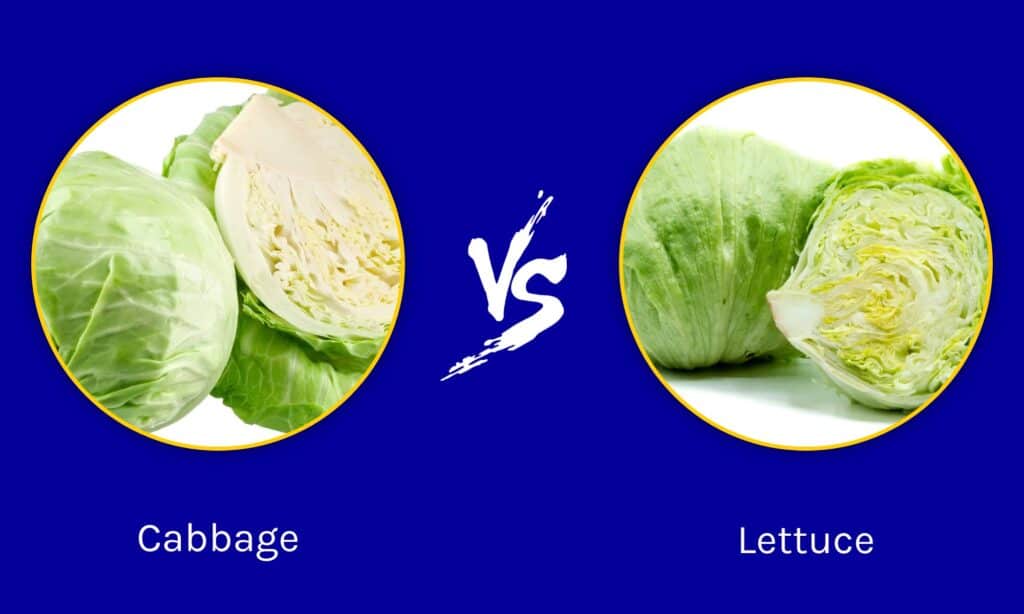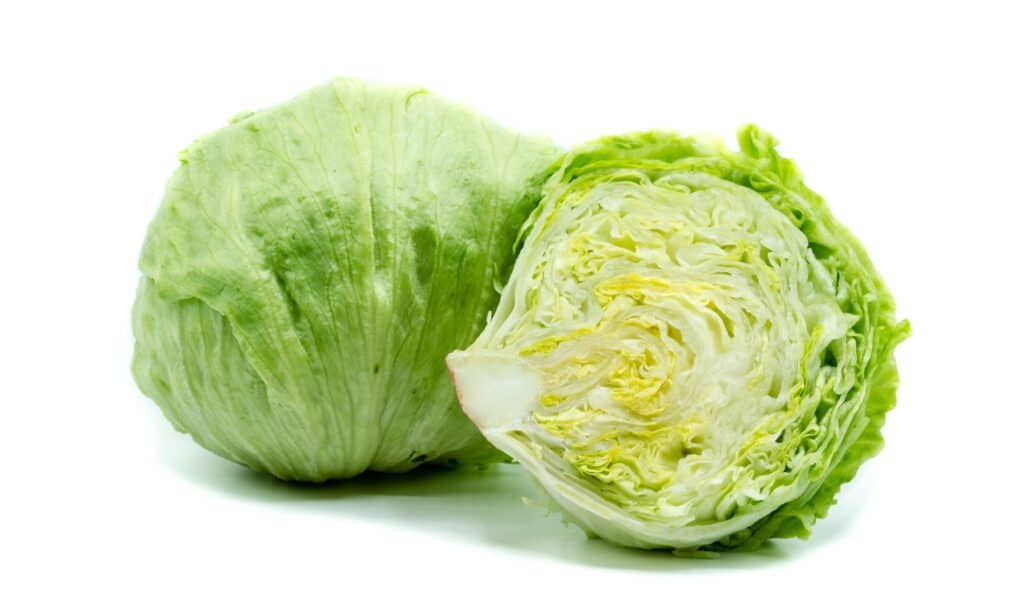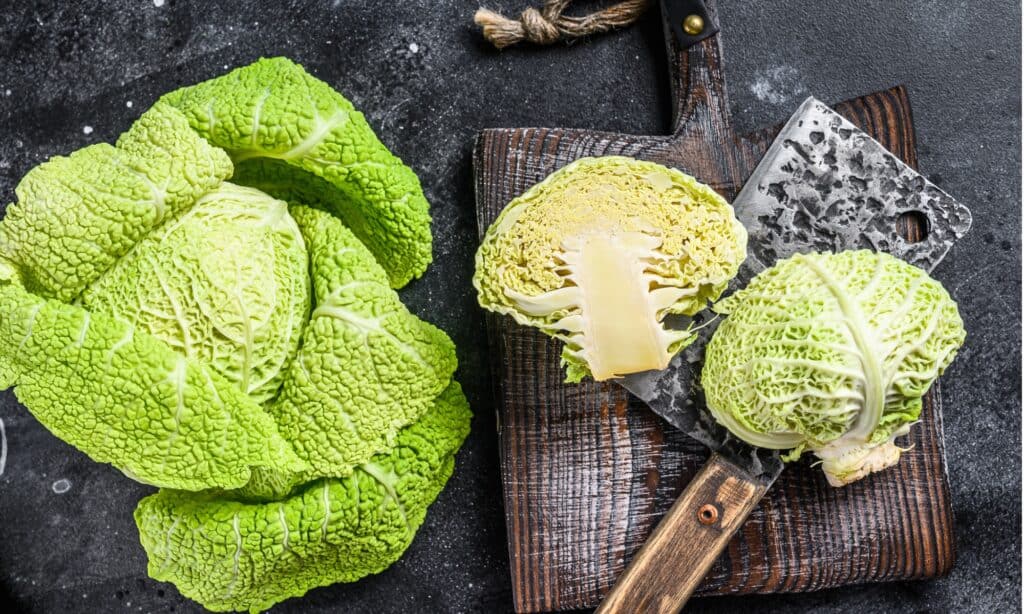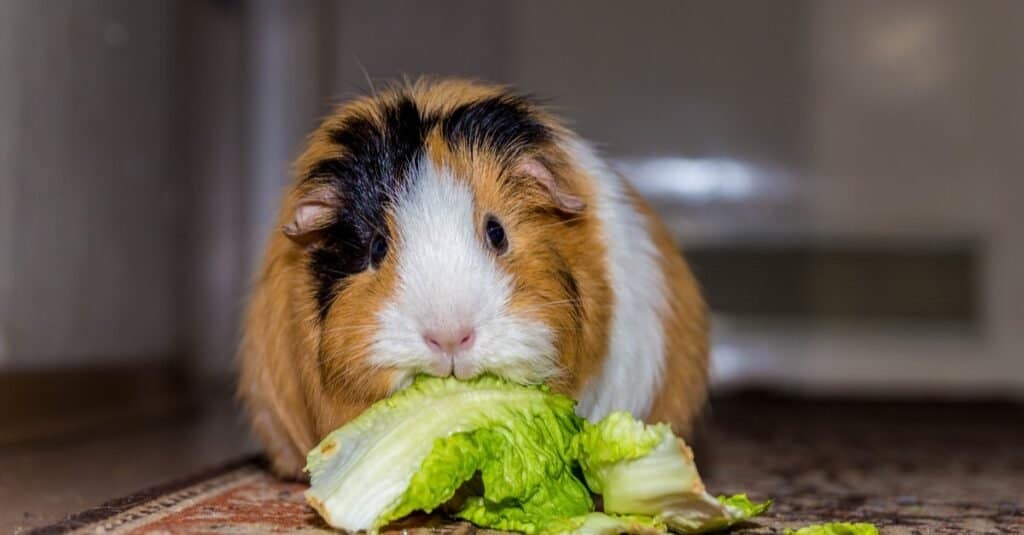With undeniable similarities in their appearances, there are still a number of differences between cabbage vs lettuce. But which of these vegetables is more nutritionally dense, and how can you learn how to tell these plants apart upon first glance? What makes cabbage special, and why is lettuce such a popular vegetable?
In this article, we will compare and contrast lettuce and cabbage so that you can fully understand the differences between them. We will go over their physical appearances and what they are typically used for, as well as their nutritional value and what makes them special. Let’s get started and learn all about lettuce and cabbage now!
Comparing Cabbage vs Lettuce

| Cabbage | Lettuce | |
|---|---|---|
| Classification | Brassica oleracea | Lactuca sativa |
| Description | Round or oblong vegetable made up of compacted or frilly leaves, depending on the species. Dense, heavy, and ranges in color from green to red, but typically remains light in shade. Peppery and sweet, mild in flavor, and only gets sweeter as you cook it. | Varies in color and shape depending on species, but comes in shades of green and red especially. Leaves are typically loose and feathered, wrinkled and veined. |
| Uses | Eaten raw, sauteed, roasted, stir fried, pickled, steamed, boiled, fermented, and more. Leaves are sturdy enough that you can wrap things in them, even after blanching | Primarily eaten raw, but can also be grilled, sauteed, and more depending on the variety. Tends to wilt and turn mushy when cooked or heated |
| Nutrition Info | Full of Vitamin K and Vitamin C, as well as fiber | Includes some vitamins and minerals, but is primarily water |
| Special Features | Originating in China sometime during 4000 BC, cabbage is one of the oldest vegetables known to man! | Renowned for its religious and medicinal history, dating as far back as 3000 BC! |
Key Differences Between Cabbage vs Lettuce

Lettuce and cabbage belong to different plant families and are not related to one another.
©iStock.com/DutchScenery
There are a number of key differences between cabbage and lettuce. For example, lettuce and cabbage are members of different plant families. In addition, there are more varieties of lettuce than there are varieties of cabbage. Lettuce is typically eaten raw, while cabbage is eaten in a variety of other ways. Finally, cabbage is more nutritionally dense compared to lettuce.
Let’s go over all of these differences in more detail now.
Cabbage vs Lettuce: Classification
While they may look similar to one another, lettuce and cabbage belong to different plant families and are not related to one another. For example, lettuce belongs to the Asteraceae family, while cabbage belongs to the Brassicaceae family. Diving into more detail, cabbage is generally classified as Brassica oleracea, while lettuce is classified as Lactuca sativa.
Cabbage vs Lettuce: Description

Lettuce leaves tend to have more texture and wrinkles compared to the smooth leaves found on cabbage.
©iStock.com/wjarek
Depending on the variety, it can be difficult to tell cabbage and lettuce apart from one another. They both come in shades of green or red, and both lettuce and cabbage can be round in shape or oblong. However, the leaves of cabbage are generally more compacted and crisp compared to the leaves found on heads of lettuce.
In addition to the way that these crops are shaped, lettuce leaves tend to have more texture and wrinkles compared to the smooth leaves found on cabbage. However, even different varieties of cabbage exhibit frilly or lacy leaves, such as savoy cabbage or napa cabbage. For the most part, lettuce leaves have a softer texture compared to cabbage leaves, but it always depends on the specific varieties you are comparing!
Cabbage vs Lettuce: Uses

Lettuce is typically eaten raw, while cabbage can be eaten raw or cooked.
©iStock.com/Animaflora
Depending on where you live in the world, cabbage and lettuce are used in similar fashions. However, when it comes to their culinary uses, lettuce is typically eaten raw nowadays, while cabbage can be eaten raw or cooked. However, some areas of the world grill or saute lettuce, just as you would cabbage.
The overall flavor of cabbage compared to the flavor of lettuce is mild, as lettuce tends to be more bitter and spicy by comparison. In addition, should you choose to cook lettuce and cabbage, lettuce leaves get mushier compared to the leaves found on cabbage. You can easily wrap things in cooked cabbage leaves, while you will have better luck wrapping something in a raw lettuce leaf over a cooked one!
Cabbage vs Lettuce: Nutrition Information

Cabbage contains high amounts of vitamin C and vitamin K, while lettuce has smaller amounts of both of these things.
©iStock.com/Vladimir Mironov
While it depends on the variety, there is very little competition between the nutritional value of cabbage versus the nutritional value of lettuce. For the most part, lettuce contains far more water content compared to cabbage, while cabbage contains more vitamins and minerals compared to lettuce.
Looking at these two vegetables in more detail, cabbage contains high amounts of vitamin C and vitamin K, while lettuce has smaller amounts of both of these things. In addition, cabbage contains higher levels of fiber compared to lettuce, though both are valuable when eaten as part of a low calorie and carbohydrate diet.
Cabbage vs Lettuce: Special Features

Cabbage seems to be a slightly older crop compared to lettuce.
©Tomasz Stepien/Shutterstock.com
While it may come as some surprise, both cabbage and lettuce are ancient crops that have been planted for thousands and thousands of years. However, cabbage seems to be a slightly older crop compared to lettuce. While cabbage seems to have originated in China, lettuce seems to have originated in Egypt. Both crops were highly valued and worshiped during 3000 to 4000 BC, and they are equally valued for their nutritional contents today!
Up Next
The photo featured at the top of this post is © iStock.com/DutchScenery
Thank you for reading! Have some feedback for us? Contact the AZ Animals editorial team.






